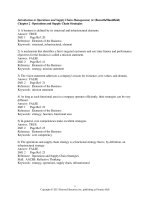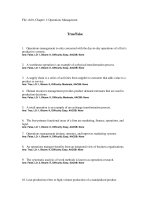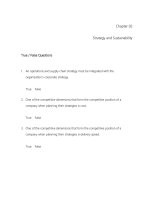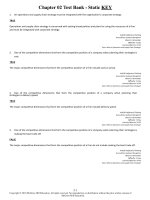Introduction to operations and supply chain management 3e bozarth chapter 07s
Bạn đang xem bản rút gọn của tài liệu. Xem và tải ngay bản đầy đủ của tài liệu tại đây (477.64 KB, 40 trang )
Supply Management
Chapter 7
Chapter Objectives
Be able to:
Identify and describe the various steps of the strategic sourcing process.
Perform and interpret the results of a simple spend analysis.
Use portfolio analysis to identify the appropriate sourcing strategy for a
particular good or service.
Describe the rationale for outsourcing and discuss when it is appropriate.
Perform a simple total cost analysis.
Show how multicriteria decision models can be used to evaluate suppliers
and interpret the results.
Understand when negotiations should be used and the purpose of
contracts.
Describe the major steps of the procure-to-pay cycle.
Discuss some of the longer-term trends in supply management and why
they are important.
Copyright © 2013 Pearson Education, Inc. publishing as Prentice Hall
7-2
Supply Management
Supply Management – The broad set of
activities carried out by organizations to
analyze sourcing opportunities, develop
sourcing strategies, select suppliers, and carry
out all the activities required to procure
goods and services.
Copyright © 2013 Pearson Education, Inc. publishing as Prentice Hall
7-3
Why is
Supply Management critical?
Global Sourcing
Competition against global competitors and their
supply chains.
Advances in information systems have helped.
Copyright © 2013 Pearson Education, Inc. publishing as Prentice Hall
7-4
Why is
Supply Management critical?
Financial Impact
Table 7.1
Copyright © 2013 Pearson Education, Inc. publishing as Prentice Hall
7-5
Why is
Supply Management critical?
Financial Impact
Cost of goods sold – The purchased cost of goods from
outside suppliers.
Merchandise inventory – A balance sheet item that shows
the amount a company paid for the inventory it has on
hand at a particular point in time.
Profit margin – The ratio of earnings to sales for a given
time period.
Return on assets (ROA) – A measure of financial
performance defined as Earnings/Total Assets
Copyright © 2013 Pearson Education, Inc. publishing as Prentice Hall
7-6
Profit Leverage – Example 7.1
Financial Impact
Selected Financial
Data for Target
Corporation
Table 7.2
Profit Margin = 100% X ($4,629 / $65,786) = 7%
Return on Assets = 100% X (4,629 / $17,213) = 26.9%
Copyright © 2013 Pearson Education, Inc. publishing as Prentice Hall
7-7
Profit Leverage – Example 7.1
Financial Impact
Every dollar saved in purchasing lowers COGS by
$1 and increases pretax profit by $1.
• Profit leverage effect – A term used to describe the
effect of $1 in cost savings increasing pretax profits by
$1 and a $1 increase in sales increasing pretax profits
only by $1 multiplied by the pretax profit margin.
Every dollar saved in purchasing lowers the
merchandise inventory figure – and as a result,
total assets – by $1.
Copyright © 2013 Pearson Education, Inc. publishing as Prentice Hall
7-8
Profit Leverage – Example 7.1
3% purchasing reduction in COGS
Earnings and Expenses
Sales
COGS
Pretax earnings
Current
Reflecting Savings
$65,786
$45,725
$4,629
$65,786
$44,353
$6,001
Selected Balance Sheet Items
Merchandise inventory
$7,596
Total assets
$17,213
$7,368
$16,985
Copyright © 2013 Pearson Education, Inc. publishing as Prentice Hall
Pretax earnings
increase by $1372
(30%)
ROA increases
from 26.9% to
35.3%
7-9
Why is
Supply Management critical?
Performance Impact
Purchased goods can have a major effect on other
dimensions such as quality and delivery
performance.
Copyright © 2013 Pearson Education, Inc. publishing as Prentice Hall
7 - 10
Performance Impact – Example 7.2
Sourcing dialysis machine valves
Copyright © 2013 Pearson Education, Inc. publishing as Prentice Hall
7 - 11
Performance Impact – Example 7.2
Effect of defective dialysis machine
Interruption in patient treatment
Rescheduling difficulties
Reduction in the effective capacity for dialysis
Possible medical emergencies
Estimated cost of a failed valve = $1,000
Copyright © 2013 Pearson Education, Inc. publishing as Prentice Hall
7 - 12
Performance Impact – Example 7.2
Sourcing 50 dialysis machine valves
(Total Costs)
Copyright © 2013 Pearson Education, Inc. publishing as Prentice Hall
7 - 13
The Strategic Sourcing Process
Figure 7.1
Copyright © 2013 Pearson Education, Inc. publishing as Prentice Hall
7 - 14
Assess Opportunities
Spend Analysis – The application of
quantitative techniques to purchasing data in
an effort to better understand spending
patterns and identify opportunities for
improvement.
Copyright © 2013 Pearson Education, Inc. publishing as Prentice Hall
7 - 15
Assess Opportunities – Example 7.3
Examine the trends and
impact of spending.
Table 7.3
Figure 7.2
Copyright © 2013 Pearson Education, Inc. publishing as Prentice Hall
7 - 16
Profile Internally and Externally
Two approaches to creating profiles:
Category profile – An approach to understand all
aspects of a particular sourcing category that
could ultimately have an impact on the sourcing
strategy.
Industry Analysis – An approach to provide a more
detailed understanding of the characteristics of
the external supply base.
Copyright © 2013 Pearson Education, Inc. publishing as Prentice Hall
7 - 17
Develop the Sourcing Strategy
The Make-or-Buy Decision
A high-level, often strategic, decision regarding
which products or services will be provided
internally and which will be provided by external
supply chain partners.
• Insourcing – The use of resources within the firm to
provide products or services.
• Outsourcing – The use of supply chain partners to
provide products or services.
Copyright © 2013 Pearson Education, Inc. publishing as Prentice Hall
7 - 18
Develop the Sourcing Strategy
Advantages and Disadvantages of
Insourcing and Outsourcing
Table 7.6
Copyright © 2013 Pearson Education, Inc. publishing as Prentice Hall
7 - 19
Develop the Sourcing Strategy
Factors that affect the decision
to Insource or Outsource.
Table 7.7
Copyright © 2013 Pearson Education, Inc. publishing as Prentice Hall
7 - 20
Develop the Sourcing Strategy
Total cost analysis – A process by which a firm
seeks to identify and quantify all of the major
costs associated with various sourcing
options.
Direct costs – Costs tied directly to the level of
operations or supply chain activities.
Indirect costs – Costs that are not tied directly to
the level of operations or supply chain activity.
Copyright © 2013 Pearson Education, Inc. publishing as Prentice Hall
7 - 21
Develop the Sourcing Strategy
Insourcing and Outsourcing Costs
Table 7.8
Copyright © 2013 Pearson Education, Inc. publishing as Prentice Hall
7 - 22
Develop the Sourcing Strategy
Portfolio analysis – A structured approach
used by decision makers to develop a
sourcing strategy for a product or service,
based on the value potential and the relative
complexity or risk represented by a sourcing
opportunity.
Copyright © 2013 Pearson Education, Inc. publishing as Prentice Hall
7 - 23
Develop the Sourcing Strategy
Portfolio Analysis
The Routine Quadrant – Readily available products or services (small %
of total).
• Electronic Data Interchange
The Leverage Quadrant – Standardized and readily available products
or services (large % of total).
• Preferred suppliers
The Bottleneck Quadrant – Unique or complex products or services
supplied by few suppliers.
The Critical Quadrant - Unique or complex products or services
supplied by few suppliers, representing large % of total.
Copyright © 2013 Pearson Education, Inc. publishing as Prentice Hall
7 - 24
Develop the Sourcing Strategy
Portfolio Analysis
High
Complexity
or Risk
Impact
Bottleneck
Critical
Routine
Leverage
Low
Low
High
Value Potential
Copyright © 2013 Pearson Education, Inc. publishing as Prentice Hall
7 - 25









